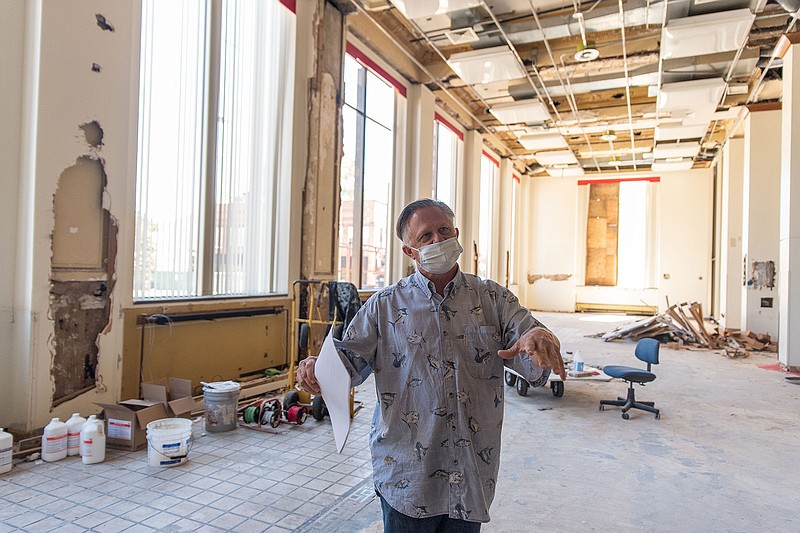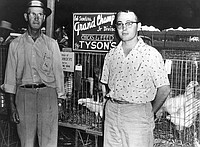TEXARKANA, Texas - The rehabilitation of the former Texarkana National Bank downtown is progressing through the initial phases of planning and hazardous materials removal, but much work remains before developer David Peavy's vision for the building will be realized.
During a walk-through of the building's first two floors Wednesday, Peavy described his plans to restore the building to a 1920s art deco style and convert it into more than 60 apartments plus retail and shared work-living spaces.
His immediate goal is to remove the pebbled stone panels covering the building's original red brick masonry, which will allow him to move forward with applying for state and federal tax credits available for rehabilitation of historic buildings. He hopes to do so in time for the Texas Historical Commission to consider his tax credit application during a January meeting. The next opportunity would not come until April.
Peavy and his partners are also in the process of applying for the building's inclusion on the National Register of Historic Places, a necessary step before the project can be considered for federal historic tax credits.
Developers awarded tax credits sell them to investors, who use them to reduce their tax bills in exchange for funds used to pay for the developers' projects. State and federal historic tax credits are parts of the financing package that made rehabilitation of the Hotel Grim possible.
In June, the City Council approved a group of loans and grants from the city for the Texarkana National Bank project, including an EPA Brownfields Cleanup loan of $400,000. The work of removing any environmental hazards from the site is in its beginning stages.
Peavy is working with an architect on floor plans for the building and intends to build a total of 63 apartments of various sizes inside. He plans to restore the building's lobby space, along with its mezzanine, to "palace"-like beauty in an art deco style fashionable around the time of the building's 1924-25 expansion.
Restoration of the ground floor's granite, terra cotta and brick exterior is also under way, using a variety of techniques to clean and repair the structure and its sculptural ornamentation. Plans include installing new windows with frames in the original hunter green and painting stucco portions of the exterior a red that matches the bricks.
The vision extends beyond the building itself. Peavy would like to partner with others to enhance the median triangle where Pine Street meets North State Line Avenue. He also sees a skyway connecting the Texarkana National Bank building to the parking garage a block away, which came with the building, so future residents can park there and walk directly to the apartments.
Made of red brick with classical-style ornamentation, the eight-story Texarkana National Bank was built around 1914 at West Broad Street and North State Line Avenue. Originally tall and narrow, the bank doubled its available rental space in the 1920s by expanding to the west.
Around 1970, an attempt to modernize the building's look encased it in white aluminum, stucco and marble.
Texarkana National Bank remained the building's prime occupant between 1920 and 1997. Doctors, lawyers, dentists, architects, investment firms and construction companies also operated in the building.
Texarkana National Bank's departure in 1997 led to a mass tenant exodus from the building between 1997 and 2004. By that time, New Orleans-based Hibernia Bank had become the sole tenant, eventually giving way to Capital One, which also left the building a few years later.
Peavy's other downtown ventures include 1894 City Market, formerly known as the Ritchie Grocery Building, which he is continuing to renovate into apartments; office space; entertainment venues; and retail outlets such as an art gallery. Peavy also owns the Flying Crow, a former railroad dining car he converted into a cafe. Both are at Front and Olive streets.
The Texarkana National Bank building project is the latest in a series of recent downtown redevelopment efforts, including the ongoing rehabilitation of the Hotel Grim, expected to be completed in spring 2021.



